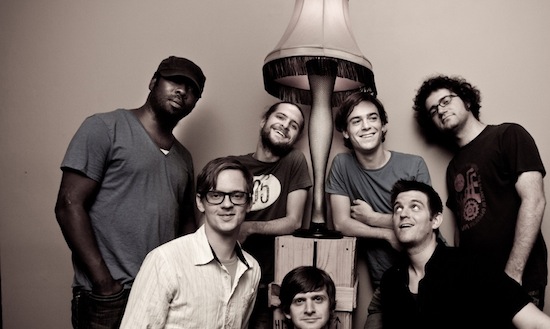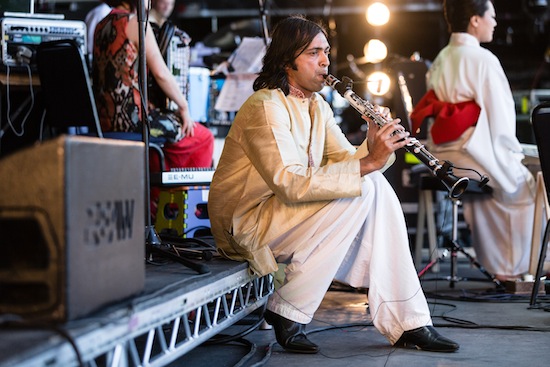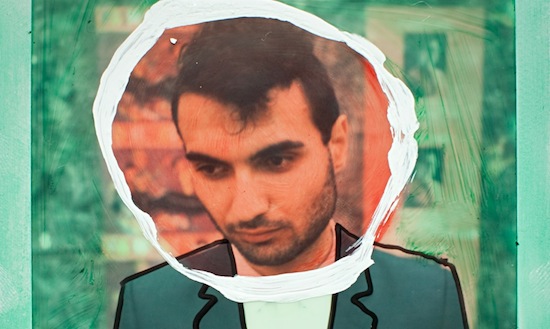What’s the point claiming 2013 was an exceptional year for jazz? Clearly, each year since it was seeded in New Orleans (or rather, Africa) the genre, broadly speaking, has produced spectacular, transcendent, transportative and historic artists, albums, and the like. If there’s one genre that can be depended on for generating top quality material year in, year out, it’s jazz.
Saying that, 2013 was undoubtedly a notable year for British jazz. British-Asian clarinettist Arun Ghosh released one of the best, if not the best, albums of the year in the shape of the gorgeous, evocative A South Asian Suite; we witnessed the scorching rise of London-based quartet Sons Of Kemet; Britain hosted its first greenfield jazz gathering in 20 years with A Love Supreme; and Whirlwind Records expanded its restless operations via a relentlessly inspiring three-day festival staged back in October. What’s more, the full houses at 21st birthday of EFG London Jazz Festival, showed that, far from faltering, the genre was displaying a firm resolve to make it through these bleak and trying times.
Until this column returns in the new year, keep the home fires burning, your treasured LPs spinning, and enjoy this EFG London Jazz Festival special, which features a review of Armenian piano wunderkid Tigran Hamasyan’s excellent Shadow Theatre plus a retrospective glance at some of the most stonking jazz releases of 2013.
Tigran – Shadow Theatre
(Universal)
On his spellbinding solo debut LP, A Fable, 26-year-old Armenia-born pianist Tigran Hamasyan established himself as a composer with an old head on young shoulders. Casting aside the energetic yet relatively straight-ahead modern-jazz trio that recorded 2008’s New Era, Hamasyan undertook a solo coming-of-age journey into the wilderness with A Fable and returned an extremely mature, dazzlingly proficient star. On it, he spun childlike melodies into Liszt-sounding rhapsodies; modal, folkloric stomps entwined with Debussy-style arabesques. All the while, Hamasyan played (and sung) with the electric, emotional drive of Keith Jarret. Darkly alluring throughout, the album’s underlying majesty and maturity seemed to belie Hamasyan’s then tender 25 years.
With Shadow Theatre, the pianist wunderkid returns to band format, and, while retaining his penchant for ancient folklore, harnesses styles more commonly associated with his age bracket. Indeed, Hamasyan recently revealed a fraction of his iPod playlist (J Dilla, Flying Lotus, Radiohead, Skrillex and a thumping selection of thrash metal), which strongly suggests he’s just as at home with 6Music-endorsed acts as Radio 3-friendly composers. Hamasyan has been given the royal blessing by a handful of jazz elder statesmen including Herbie Hancock and Chick Corea; but by the same token, as evidenced by the pop-via-folk-via-rock jazzscapes of Shadow Theatre, more mainstream figureheads such as Steve Reich, Tony Iommi, Sigur Ros, Jonny Greenwood and Tim Burton might just as easily bestow the Armenian with their seal of approval.
The gothic, carnivalesque pound of ‘Erishta’ draws on the otherworldly swoops of a Danny Elfman soundtrack. Elsewhere, Hamasyan’s childhood love of Black Sabbath is manifest in ‘Drip’, on which steely, industrial-strength riffs are punctuated by squelchy bass and cosmic sax.
EFG 21st London Jazz Festival
Various venues, Friday November 15 – Sunday November 24
The death of jazz is a tediously recurring narrative in the music press. And on the eve of the EFG London Jazz Festival 2013 the very same narrative was revisited yet again by The Independent’s Phil Johnson, in a black-sky-thinking piece entitled ‘Is Jazz A Dying Artform?’ In it, Johnson highlights the depletion of jazz audiences, the ever-aging nature of those who actually attend concerts and the genre’s "increasing lack of visibility in the mainstream media", among other issues.
It’s precisely articles like this one that inspired me to establish this column. Because from where I’m sitting/standing, the genre is not only thriving, but worth getting into right now – as proven by the 21st birthday of the capital’s largest city-wide festival.
Celebrations like this one are vital for the future of the genre – and also a great place for newcomers to jazz to start. Many of the festival’s shows were free, making it possible for fans to spend many a curious hour wandering among the public spaces of the Southbank, getting lost in anything from the soul-enlivening strains of youth-led big bands or the fiery whims of jazz-rock trios.
Not just a platform across which disparate musicians perform, the festival is a vibrant cultural cornerstone on which significant artistic communities are built. With over 2,500 artists (from time-honoured stars to young explorers) playing in 60 venues over 10 days, not to mention heated discussions, participatory workshops and film screenings, the festival’s a triumphant reminder that the jazz world is as much about audience involvement as it is the diverse streams of music.
The festival is so vast that, in a sense, you could call it the ‘Glastonbury’ of UK jazz events (it spanned from Harrow to Greenwich and from Deptford to Finchley) – minus the raving to hard beats outside a burger van at 4am, of course. Indeed, instead of schlepping through miles of mud, you’re generally treated to a comfy seat in a plush theatre from which you can sip your beer and headbang to your heart’s content to some of the most transcendent music going. What more could you want?
Each year, thematic strands emerge in the programme that take the audience on a journey. Largely, this year the festival has looked to the east for inspiration (hello Remember Shakti, Arun Ghosh, Gilad Atzmon and Tigran Hamasyan). Whichever thread you caught on to, however, one thing remained constant: every aspect of the festival was all inclusive, and everywhere you turned, headbangers, hip hop heads, electronica geeks, pop fans and jazz squares were equally catered for. For, ultimately, jazz is for every type of music fan, not one person excluded.
Snarky Puppy
Village Underground, Shoreditch, Sunday November 17

High-energy modern jazz-funk crew Snarky Puppy are the ultimate festival band. Wherever they go, they dependably blow off the roof, whether it’s at British greenfield festivals like Latitude and Bestival or outdoor jazz gatherings like Love Supreme (and that’s just in Britain). Not only do they deploy uplifting fusion that moves "the brain and booty", but they possess a playful, personable, humble and magnetic nature which has helped them build a strong rapport with their audiences. It explains the long line that snaked around the building before their performance.
"Work hard, play hard" should be their motto. They’ve recorded not one, not two, but three LPs this year and have performed live 184 times, this outing at Shoreditch’s hangar-sized Village Underground being their last of 2013. Most bands by this point would have come close to burn out, but, even when operating on low batteries, Snarky Puppy could knock most jam bands into a cocked hat. Their two-and-a-quarter set of joie-de-vivre jazz took in retro 70s funk, rock, hip-hop, soul, electronica and ethnic idioms, bringing to mind the likes of Frank Zappa, Stevie Wonder, Weather Report, Prince, Bjork, George Duke, Jamiroquai, Little Feat, Brand X and Bill Bruford, all often in the course of one track.
This floating community of musicians played as an eight piece, with bandleader and bassist Michael League, who elicited facial gymnastics that would make Este Haim’s look stony, front and centre. The majority of their set was drawn from new material, which will feature on their as yet untitled eighth LP, slated for release next February. Nevertheless, crowd favourites came thick and fast. ‘Binky’ was a hip-hop grower that, in the space of ten minutes, morphed from creeping funk to skying jazz and finally ended on an epic, stadium-filling rock refrain. Meanwhile, ‘Thing Of Gold’ was laden with hooks big enough to hang a shark on. By the end, the audience were audibly enraptured, clapping along incessantly, even when the time signatures got itchy.
Tigran Hamasyan
Queen Elizabeth Hall, Southbank, Tuesday November
The Queen Elizabeth Hall’s stage was studded with huge, operation-table spotlights. It’s a fitting scene, since Armenian piano upstart Tigran jumped and jerked at his piano like a mad scientist bringing some awful form to life. Moreover, his tunes were by turns theatrical and monstrous: beats crunched and pounded, singer Areni Agbabian’s vocals hovered and swooped with ghostly eeriness, and Tigran’s piano seemed to be haunted by Armenian folkloric melodies and the spirit of Black Sabbath.
If there were punters expecting a re-run of Tigran’s solo concert at the Wigmore Hall last year, they got one hell of a shock. Tigran returned to a band set-up, and some of his members, with their tousled long locks and jeans, looked like they could just as well have been standing in for someone of Queens Of The Stone Age. From the flashing strobes to Charles Alturo’s protracted guitar wig-out during ‘The Poet’, from the pop-song structures to Tigran’s incessant headbanging, this concert was, for all intents and purposes, a stadium-ready rock gig.
But, of course, Tigran is no meat-and-potatoes rocker. His tunes, many of which are sourced from his latest album, Shadow Theatre, were simultaneously delicate, heavy, light, dark, enchanting and frightening – much like Bjork’s back catalogue. And like Bjork, Tigran has a penchant for electronica-powered beats and glitches. Unexpectedly, during the set’s climax, he dropped a gargantuan dubstep-rock mash-up, seemingly identifying the young composer as the second producer The Prodigy never had.
Sons Of Kemet
Barbican, Thursday November 21
On stage, the dry ice machine had seemingly malfunctioned. As Sons Of Kemet walked on, the platform was completely, and comically, enveloped in fog. Fittingly for a band whose new album’s called Burn, it looked like the building was on fire. From the first notes, however, it turned out to be the band that was smoking.
Headlining the Barbican was a big step up for the quirky London quartet, who launched their aforementioned debut LP earlier this year in the cosier surroundings of the Vortex Jazz Club. Yet they rose to the occasion in thundering style, playing a thrilling, albeit short, set of warped New Orleans-style jazz, afrobeat, dub and rock.
Led by beanpole saxist-clarinettist, Shabaka Hutchings, whose middle-eastern phrases hit hard as much as they caressed, the band raced through their set with few pauses, and no encore. The superstar tag-team drum duo of Tom Skinner and Seb Rochford clattered their way through pulsing, danceable rhythms, while tuba whisperer Oren Marshall at times kept his beast on a leash, and at others let it roar.
For a band whose new album is replete with highbrow overtones (‘All Will Surely Burn’ is a furious blast against global warming), Sons Of Kemet sure knew how to raise a laugh, Marshall being the band’s jester-in-chief. His at times side-splitting tuba sounds metamorphosed freely: a herd of trumpeting elephants one minute, a swarm of bees the next. Sometimes he even made it groan and snarl devilishly, like Bill Hicks’ infamous ‘Goatboy’ character.
Sons Of Kemet are truly a different beast altogether.
Troyk-estra
Purcell Rooms, Southbank, Saturday November 23
The people at Jazzwise magazine should take a bow, for it was they who matchmade cutting-edge fusion trio Troyka and the excellent big band directed by the Royal Academy of Music’s Nick Smart – thus bringing together the formidable Troyk-estra. The magazine commissioned the outfit to play their 15th birthday celebration. The band were so hot, they decided to take it further, hence the recently released Live At Cheltenham Jazz Festival LP.
Troyk-estra’s appearance at the Purcell Rooms was one of a handful since their Jazzwise commission, and, at times, due to uneven sound levels and tentative playing on the core trio’s part, their short time together showed.
When the two constituent parts combined harmoniously, however, the result was blinding. The luxurious, sweeping brass accompaniment proved to be a perfect foil for Chris Montague’s prog-y guitar textures on ‘Dropsy’. In mellower moods, like on ‘Chaplin’, on which reflective brass swells enveloped Kit Downes’ elegant piano chords, the band proved to be a breath-catching prospect.
Arun Ghosh’s Arkestra Makara
The Albany, Deptford, Sunday November 24

Back in October, British-Asian clarinettist Arun Ghosh released one of the best albums of the year with of A South Asian Suite. Pushing forward his spicy template of indo-jazz fusion, his suite had a wider emotional scope than his previous two recordings, astutely balancing his penchant for a danceable rhythms with moments of gorgeous, pastoral reflection. This talent for perfectly harmonising heart-leaping moments of rhythmic ecstasy with softer, zen-like states was at the heart of Arkestra Makara‘s gig, and, as such, made for an appropriate closing ceremony for the festival.
Geographically, Ghosh spreads his net wider with Arkestra Makara. On South Asian Suite his tunes encompassed the folkloric sounds of India, Pakistan, Sri Lanka and Nepal, but with this particular outfit, he brought together musical and cultural influences from Japan to China via Singapore and Malaysia, as well as the Indian subcontinent. All, of course, stamped with a contemporary, rock-leaning edge.
The outfit is aptly named. Much of what Arkestra Makara played instinctively tapped into jazz-journeyer Sun Ra’s psychedelic explorations. The 11-piece are equipped with an exotic, mind-blowing arrange of instruments, a few of which this writer had never seen or heard of before, including the sitar-like sarod, the Chinese two-stringed erhu, and the jinghu, a small, high-pitched bowed instrument also from China.
From the hypnotic drone of set opener ‘Hark, The Arkestra Awakes’, this smorgasbord band, led by Ghosh and his free-flying clarinet lines, evoked cinematic landscapes dominated by mist-scarved mountains, murmuring rivers, and serene skies. On the blistering, Ghosh-penned ‘Journey South’, the mantra-like rhythms became melodies in themselves, and, the set’s centrepiece, ‘Sufi Stomp (Soul Of Sindh)’ a roof-raising devotional dance, could ignite dance floors from Manchester to Mumbai.
Albums of 2013
John Escreet – Sabotage and Celebration
(Whirlwind)
Doncaster-born New York-based pianist and composer John Escreet didn’t pull any punches with his fifth album, whose title alludes to the emotions of US election night (November 7, 2012), when Barack Obama’s second-term victory overcame reported ‘voter sabotage.’ From the off, a disorientating, chattering, fiery and elating masterstroke.
Kit Downes – Light From Old Stars
(Basho)
Despite the cosmos-referencing album title, Troyka keys man Kit Downes keeps the tone surprisingly earthy on this blues-inflected straight-ahead jazz offering. Of course, light from old stars of the jazz world guides Downes through this beauteous LP.
The Impossible Gentlemen – Internationally Recognised Aliens
(Basho)
The family-album-like photos on this album’s inlay are suggestive of a band who like to cut loose and banter with each other. This sense of jesting casualness extends to the music, too, thanks to the freewheeling, blues-funk improv that studs this restless, cheery album.
Vijay Iyer & Mike Ladd – Holding It Down: The Veterans’ Dreams Project
(PI)
Can music change politics? If any musical project could lay claim to influencing the way we think about politics and humanity in a post 9/11 world, it’s jazz pianist Vijay Iyer and hip-hop artist Mike Ladd’s The Veterans’ Dreams Project, a cathartic, terrifying descent into dreamworld of ex-soldiers who fought in the Iraq and Afghanistan wars. Probably one of the most frightening ‘jazz’ album you are ever likely to hear.
Satelliti – Transister
(Cuckundoo Records)
Not a jazz album per se, Italian duo Satelliti’s Transister is nonetheless keyed-up on Bitches Brew-era Miles Davis and propelled by techno and krautrock rhythms. Fusion perfect for blaring out on an eardrum-bursting soundsystem.
Troyk-estra – Live At Cheltenham Jazz Festival
(Impossible Ark)
Since their inception, contemporary fusion trio Troyka have stirred up huge soundscapes. But merged with the Royal Academy of Music’s excellent big band, they now sound absolutely stratospheric. A giant leap in sound for the London trio, but one that sounds entirely natural.
Fringe Magnetic – Clocca
(Loop)
This is the third and final LP from the project led by Jamie Callum’s sidekick, Rory Simmons. The writings of contemporary novelists including Douglas Coupland figure in this gothic, pastoral album as much as the chaotic flurries of woodwind, brass and electronica.
Marius Neset – Birds
(Edition)
You can always expect the unexpected with Scandinavian composers. 27-year-old saxist and composer Marius Neset has been hailed "the most talented Norwegian saxophonist since Jan Garbarek in the 1960s", but Neset’s compositions range from the chattering density of Frank Zappa circa Hot Rats to the melodic hypnotism of Steve Reich. Birds is a wild, symphonic and metamorphic recording.
Antonio Sanchez – New Life
(Cam Jazz)
Antonio Sanchez has been the driving force behind guitar legend Pat Metheny since 2002. In the past decade, he has also collaborated with the likes of firebrand saxist Miguel Zenon, trumpeters Alex Sipiagin and Diego Urcola and singer Dianne Reeves. This eclectic session, which features a dazzling array of stars including pianist John Escreet and saxist David Binney, is Sanchez’s most surprising, far-reaching recording yet.
Alexi Tuomarila Trio – Seven Hills
(Edition)
European piano trios are ten a penny, but the Alexi Tuomarila Trio breath new life into an old template on Seven Hills. This album’s certainly redolent of e.s.t’s work, but the Finnish pianist Tuomarila’s melodic grace and dazzling improv are all his own.


